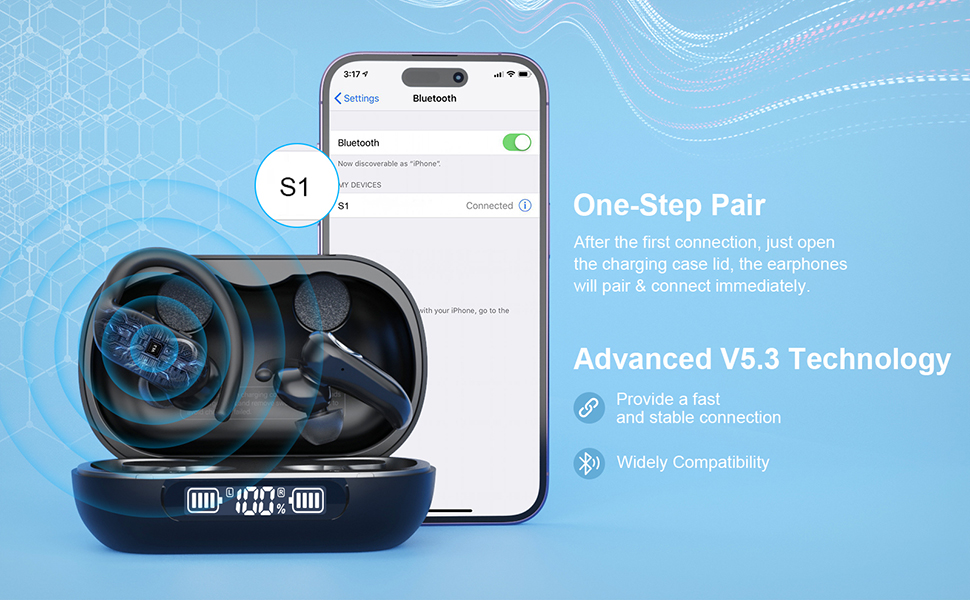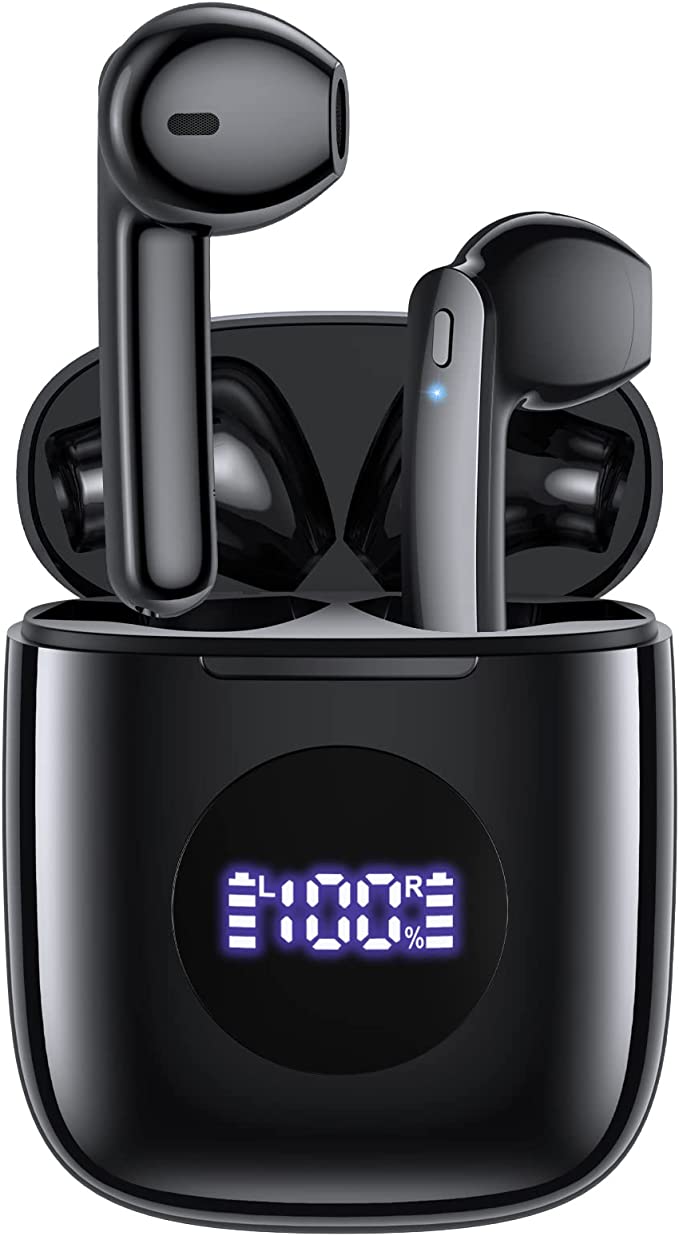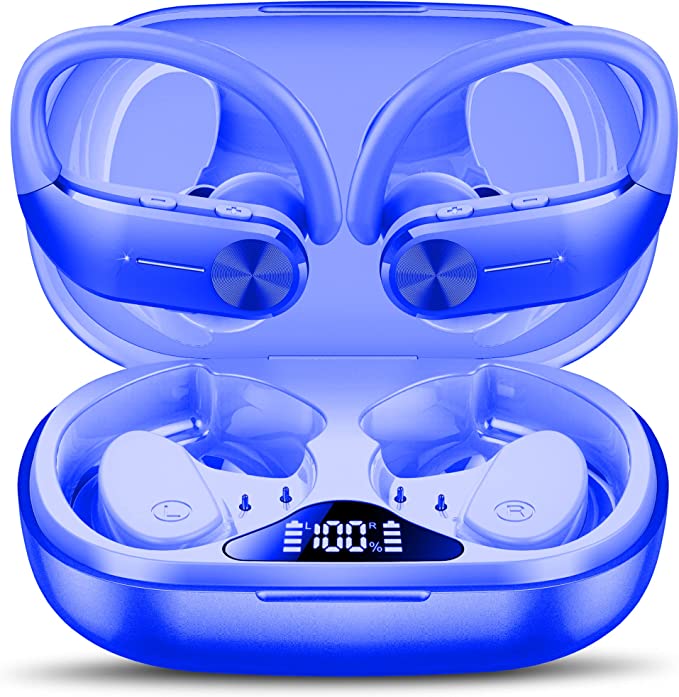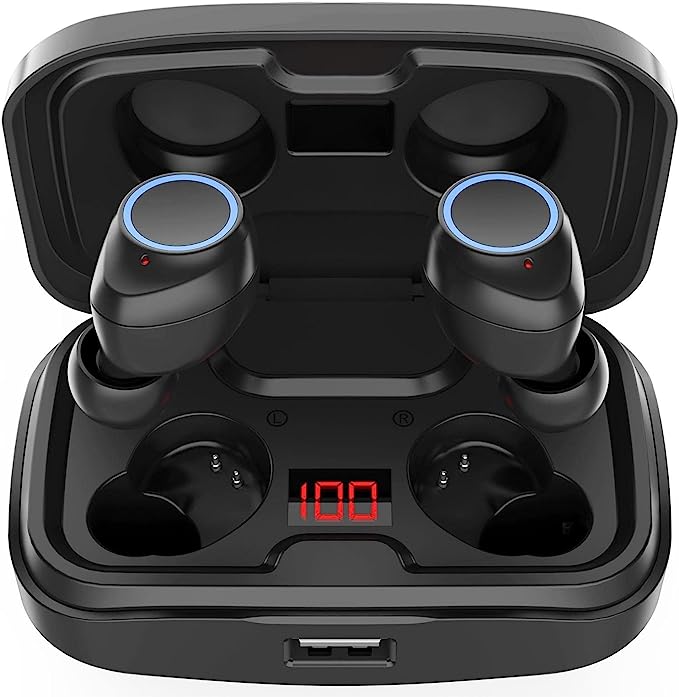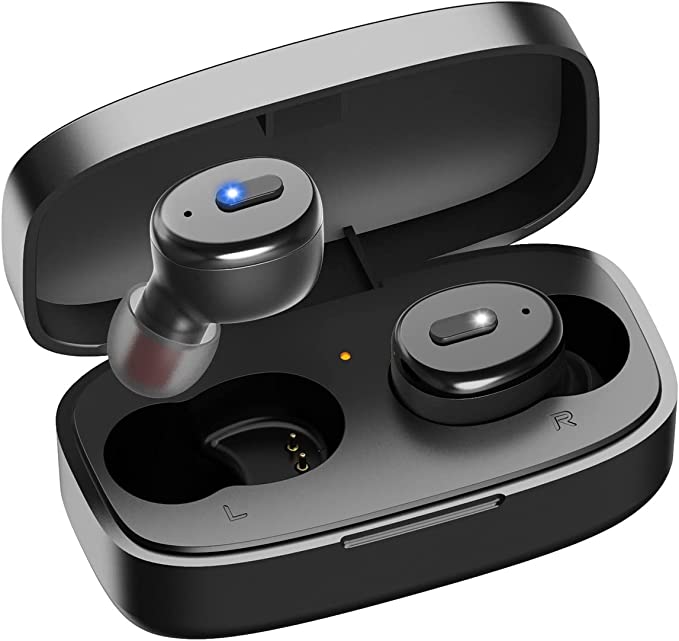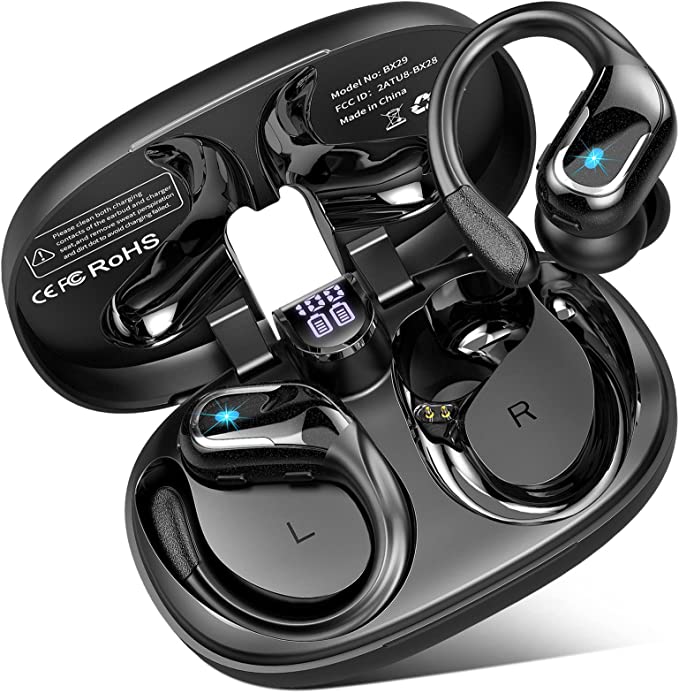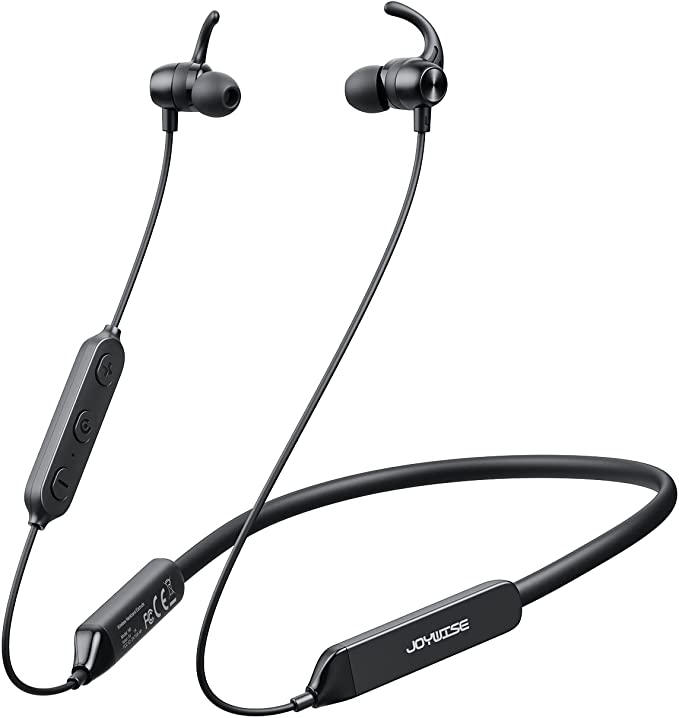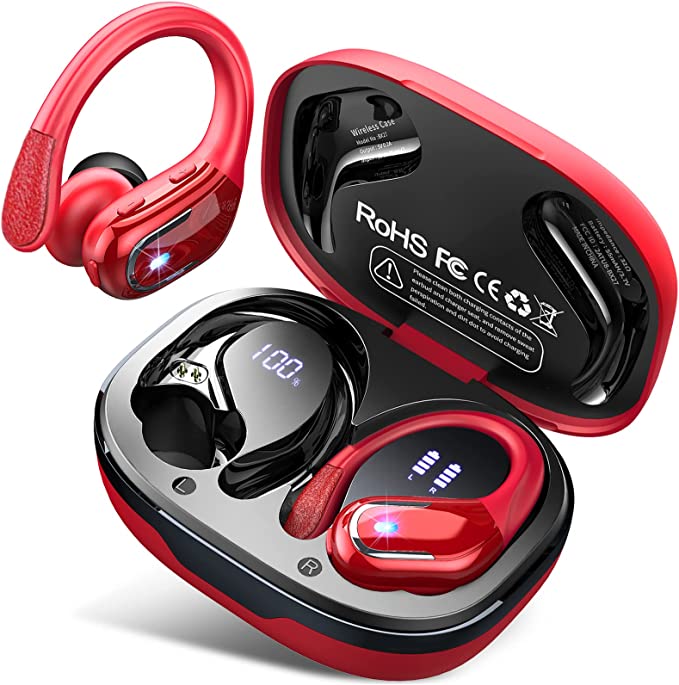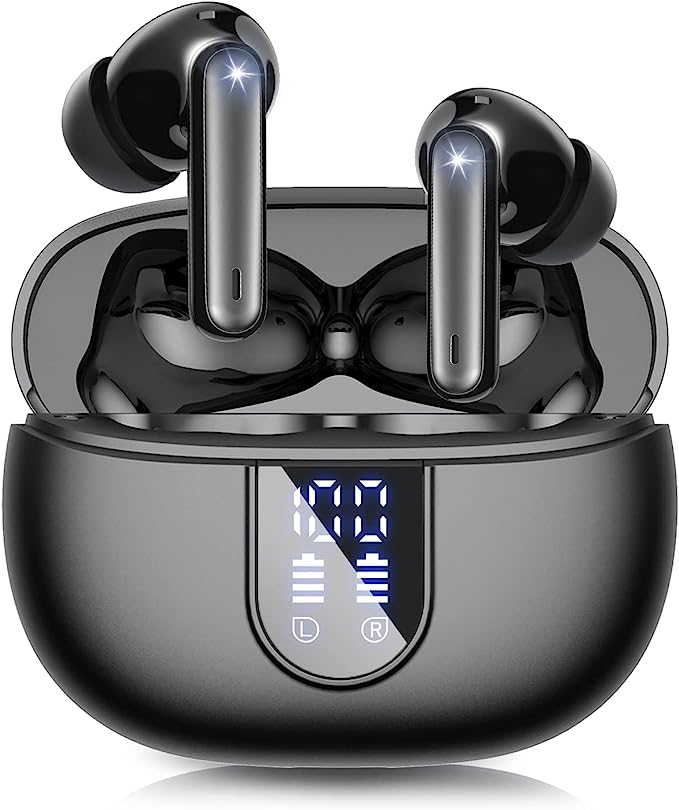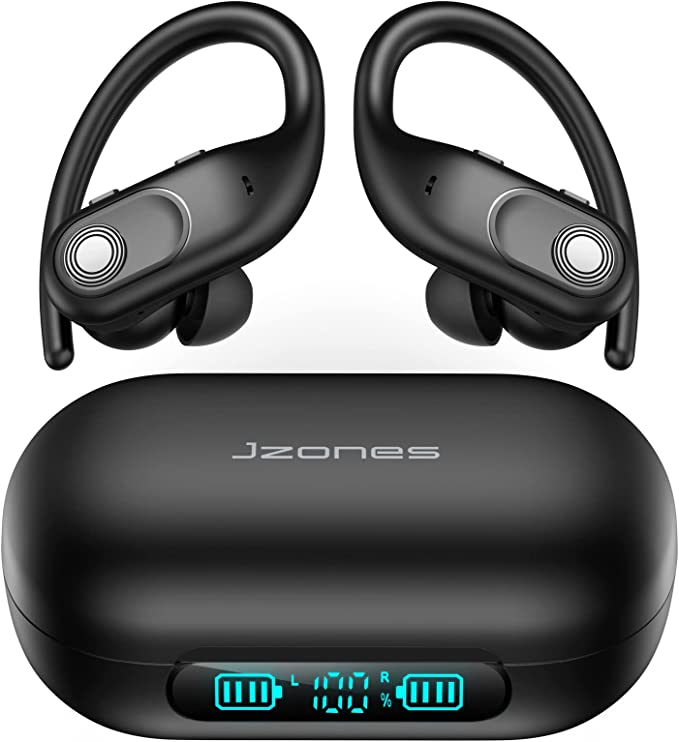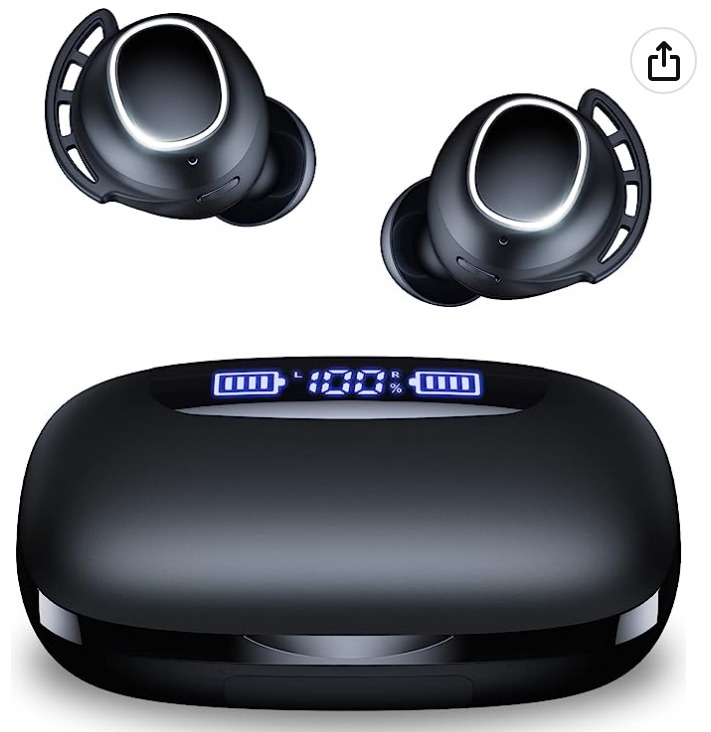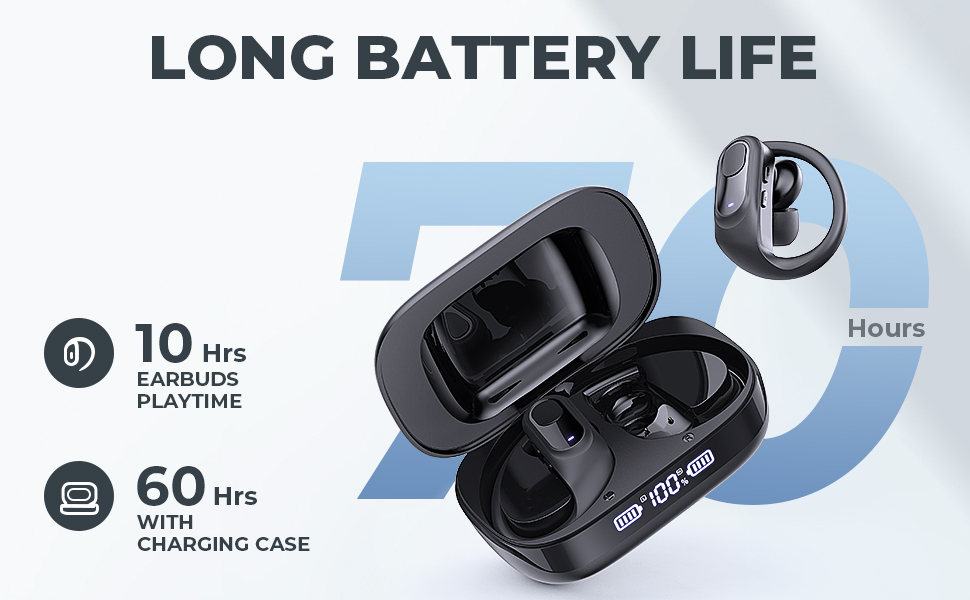KT1 Q25 Wireless Earbuds: The Science of All-Day Audio and Rugged Performance
Update on May 30, 2025, 9:14 a.m.
In our always-on, ever-moving world, the soundtrack to our lives has largely untethered itself from the tyranny of wires. We crave the freedom of wireless audio, whether we’re pounding the pavement on a morning run, lost in a podcast on a crowded commute, or simply seeking a personal oasis of sound. Yet, this wireless dream isn’t without its occasional nightmares: the jarring silence of a dead battery mid-anthem, the frustrating stutter of a connection dropping at a crucial moment, or the discomfort of earbuds that just won’t stay put. The KT1 Q25 wireless earbuds, like many of their contemporaries, step onto this stage promising a harmonious blend of endurance, connectivity, and comfort. But beyond the bullet points on a product page, what fascinating science and ingenious engineering principles are at play to make this possible? Let’s peel back the layers.

The Unseen Symphony: How Bluetooth 5.3 Conducts Your Audio World
At the very heart of your wireless experience with the KT1 Q25 lies Bluetooth technology, a silent conductor orchestrating the flow of your audio. It’s a technology many of us take for granted, but its journey from a hopeful cable-replacement project in the late 1990s by Ericsson (aptly named after Harald Bluetooth, a 10th-century Danish king known for uniting disparate Danish tribes) to the sophisticated standard it is today is a testament to relentless innovation. The Q25 model comes equipped with Bluetooth 5.3, a specific iteration that brings several enhancements to the listening experience.
You might wonder, what does a version number like “5.3” truly mean for your daily use? Think of it as moving from a winding country road to a multi-lane expressway for your audio data. One of the primary pursuits in Bluetooth evolution has been stability. In our modern environments, the airwaves are increasingly crowded with signals from Wi-Fi routers, microwaves, and countless other wireless devices, all vying for space. Bluetooth 5.3 incorporates improved mechanisms, such as better channel classification (allowing the device to more intelligently hop between frequencies to avoid interference), which contributes to a more robust and less stutter-prone connection. The KT1 Q25 also mentions an “advanced ceramic antenna” and a claimed “signal enhancement 50%.” While the specifics of this enhancement would require detailed proprietary data, it’s well-understood in radio frequency engineering that antenna design and material (ceramics can offer good performance and miniaturization) are critical for maintaining signal integrity, especially in compact devices like earbuds. A well-designed antenna acts like a more sensitive ear, better able to pick up and hold onto the Bluetooth signal from your phone or other source device, even when conditions aren’t perfect.
Then there’s the crucial aspect of latency. Ever watched a video where the audio lags ever so slightly behind the on-screen action, creating an almost imperceptible but vaguely unsettling disconnect? That’s latency. The KT1 Q25 product information cites an “ultra-low latency” of 42 milliseconds (ms). To put this in perspective, human perception of audio-visual asynchrony can start to become noticeable around 100-200ms for some, and much lower for highly sensitive tasks like gaming. While 42ms is a manufacturer claim, Bluetooth 5.3 itself does bring features that facilitate lower latency, including more efficient data packet handling and improved scheduling. Imagine a perfectly synchronized conversation, with no awkward delays – that’s the goal for your audio and video.
Finally, Bluetooth 5.3 continues the trend of power efficiency. Your earbuds are tiny, and so are their batteries. Every milliwatt of power saved in transmission or idle states translates directly into longer listening time before you need to pop them back into their charging case. This efficiency is achieved through various means, including smarter sleep modes and more optimized data transfer protocols, ensuring your earbuds are sipping power, not gulping it.

The Marathon Runner’s Heart: Engineering 120 Hours of Auditory Freedom
One of the standout claims for the KT1 Q25 is an impressive 120 hours of total playtime. This kind of endurance doesn’t come from magic; it comes from a carefully balanced energy equation, powered by the workhorse of modern portable electronics: Lithium-Ion (Li-ion) battery technology.
Let’s first look at the earbuds themselves. Each tiny earpiece, according to the specifications, houses a 40mAh (milliampere-hour) battery. Think of mAh as a measure of the battery’s energy capacity – the higher the number, the more energy it can store. These diminutive power cells are feats of electrochemical engineering, relying on the movement of lithium ions between an anode and a cathode through an electrolyte to generate electrical current. The Q25 documentation suggests these can deliver around 7 hours of continuous playback on a single full charge. This is a respectable figure, achieved by balancing the power demands of the Bluetooth chip, the audio drivers, and other electronics with the limited physical space for the battery.
But the real secret to that marathon-like 120-hour figure lies within the charging case. This unassuming cradle is more than just a storage box; it’s a portable energy depot, boasting a significantly larger 2600mAh Li-ion battery. When your earbuds’ 7-hour stint is up, placing them back into the case initiates a recharge, drawing power from this much larger reservoir. If you do the math, the case holds enough energy to recharge the earbuds many times over (roughly (2600mAh * efficiency_factor) / (2 * 40mAh) times, where efficiency_factor accounts for energy losses during transfer). This cumulative effect is what pushes the total usable playtime into triple digits. It’s like having a personal fuel tanker for your earbuds, ready to top them up whenever they’re parked.
To help you manage this substantial power reserve, the Q25 case features an LED digital display. This small screen typically shows the remaining percentage of charge in the case itself, and often, the charge status of each individual earbud. It’s a simple but incredibly useful feature, transforming charge anxiety (“Will they last my whole trip?”) into informed power management. Some users, as noted in the product feedback, have even tried to use the case as an emergency power bank for their phones. While the case can technically output some power via its USB-C port, its primary design and efficiency are optimized for replenishing the earbuds. Expecting it to significantly charge a modern smartphone would be like asking a bicycle pump to inflate a truck tire – it might offer a tiny bit of help in a pinch, but it’s not its forte, and doing so will rapidly deplete the case’s reserves meant for the earbuds. Another user observation from the provided materials is that the earbuds turn on automatically when removed from the case, which is convenient, but they may not always turn off automatically when placed back in if not seated perfectly or if the case logic doesn’t support it, requiring a manual shut-off to conserve power.

Crafting Your Soundscape: Graphene, Drivers, and the Pursuit of Bass
Ultimately, earbuds live or die by the sound they produce. The KT1 Q25 aims to deliver a compelling audio experience through a combination of advanced driver materials and acoustic design, featuring 10mm graphene dynamic speaker units and what the manufacturer calls “Latest Bass 2.0 Technology.”
Let’s first understand the “voice” of the earbud: the dynamic driver. This is the most common type of driver in headphones and earbuds. In essence, it’s a miniature loudspeaker. An electrical audio signal from your device is fed into a finely wound coil of wire (the voice coil) which is attached to a thin, flexible membrane called a diaphragm. This coil is suspended within a magnetic field. When the audio current flows through the coil, it creates a fluctuating electromagnetic field that interacts with the permanent magnet, causing the coil and the attached diaphragm to vibrate rapidly back and forth. These vibrations push and pull the air, creating the sound waves that travel down your ear canal and are interpreted by your brain as music, podcasts, or a friendly voice. The size of the driver, in this case 10mm, is a factor; generally, larger diaphragms can move more air and thus have an easier time producing lower frequencies (bass), though design and tuning are paramount.
The material of this diaphragm is where graphene comes into play. Graphene is a remarkable, Nobel Prize-winning material. It’s a single layer of carbon atoms arranged in a two-dimensional honeycomb lattice. Its standout properties for audio applications are its incredible strength (reportedly 200 times stronger than steel) combined with extreme lightness and stiffness. Why does this matter for sound? A diaphragm needs to be light to respond instantly to the rapid changes in the audio signal (good transient response, for crisp details). It needs to be stiff so that it vibrates as a single, uniform piston without deforming or creating unwanted resonances (which cause distortion). Graphene’s unique combination of these traits allows it to potentially reproduce sound with greater accuracy, clarity, and less distortion compared to traditional diaphragm materials like Mylar or paper, especially across a wide frequency range.
Now, about that “Latest Bass 2.0 Technology,” which the product page claims enhances bass by 43%. “Bass 2.0” is a proprietary marketing term, so its exact technical underpinnings aren’t publicly detailed. However, in the world of audio engineering, enhancing bass typically involves a careful interplay of two main elements:
- Acoustic Design: The physical shape and volume of the earbud’s internal chamber, the porting (if any), and the way the driver is mounted all significantly influence how bass frequencies are produced and resonate. A well-designed acoustic enclosure can naturally amplify or shape the low-end response.
- Digital Signal Processing (DSP): Modern audio devices often incorporate a DSP chip. This tiny computer can analyze the incoming audio signal in real-time and apply various adjustments, including equalization (EQ). “Bass enhancement” via DSP would involve identifying the lower frequencies and selectively boosting their amplitude, much like adjusting the bass knob on a stereo system.
It’s likely that “Bass 2.0” is a combination of such physical acoustic tuning and DSP algorithms aimed at delivering that claimed 43% perceived increase in low-frequency energy. This often results in a “warmer” or more “impactful” sound signature, which many listeners find engaging for genres like pop, hip-hop, and electronic music. However, it’s worth noting the subjectivity of sound. While some crave powerful bass, others might prefer a more neutral or “flat” response where all frequencies are represented more equally. User feedback provided with the source material for the Q25 reflects this: one reviewer described the sound quality as “okay” and “not tinny,” but also mentioned potential “muffling of ranges (especially towards the bassy parts).” This suggests a sound signature that indeed emphasizes the low end, which might appeal to many but perhaps not to audiophiles seeking absolute neutrality.
Finally, the Q25 earbuds also provide a degree of passive noise isolation, with a claim of reducing noise by 15%. This isn’t active noise cancellation (which uses microphones and electronics to cancel out external sounds). Instead, it relies on the physical barrier created by the earbuds and their silicone ear tips (provided in S/M/L sizes). A snug fit that properly seals the ear canal acts much like an earplug, physically blocking a certain amount of ambient sound from reaching your eardrum. This can enhance the listening experience, especially in moderately noisy environments, by allowing you to hear more of your music and less of the world around you.

Weathering the Storm, Embracing the Movement: IPX7 and Ergonomic Design
For many, earbuds are companions for an active lifestyle – accompanying them on sweaty gym sessions, rainy day jogs, or demanding commutes. This is where durability, particularly against moisture, and a secure, comfortable fit become paramount. The KT1 Q25 addresses these needs with an IPX7 waterproof rating and an “over-ear” sport-focused ergonomic design.
Let’s decode IPX7. “IP” stands for “Ingress Protection,” and it’s a standard (IEC 60529) developed by the International Electrotechnical Commission to classify the degree of protection provided by the enclosures of electrical equipment against the intrusion of solid objects (like dust) and liquids. The first digit after “IP” relates to protection against solids, and the second digit relates to protection against liquids. In “IPX7,” the “X” means that the device has not been officially rated for protection against solid particle ingress (or the manufacturer has chosen not to conduct or publish this specific test). The “7” is the crucial part for water resistance. It signifies that the product is protected against the effects of temporary immersion in water under standardized conditions: up to 1 meter (approximately 3.3 feet) of submersion for a maximum duration of 30 minutes.
How is this level of water protection achieved in such a small device? It usually involves a combination of precise mechanical seals around any openings and, often, the application of a nano-coating to the internal circuitry. This is a microscopically thin, transparent polymer layer that is applied to the components. This coating is hydrophobic, meaning it repels water. If moisture does manage to seep past the outer seals, the nano-coating prevents it from short-circuiting the delicate electronics, acting like an invisible, high-tech raincoat at a microscopic level. This IPX7 rating makes the Q25 earbuds well-suited for withstanding sweat during intense exercise or getting caught in the rain. As one user in the provided feedback mentioned, they’ve even worn them in the shower (carefully, one presumes) without issue. However, it’s important to heed the manufacturer’s advice, also found in the product description: “Please wipe the charging pin after use to prevent sweat corrosion.” Sweat is not just water; it contains salts and other minerals that can be corrosive to the metal charging contacts over time, potentially hindering charging. Also, IPX7 does not mean the earbuds are designed for swimming, as the product information explicitly states “(Not suitable for swimming and bathing)”.
Beyond ruggedness, ergonomics – the science of designing products to fit the human body optimally – plays a huge role in how enjoyable earbuds are to use. The KT1 Q25 employs an “over-ear” design featuring “new design of soft earhook.” These flexible hooks loop over the top of your ears. The primary benefits of this design, especially for sports-oriented earbuds, are enhanced stability and better weight distribution. Instead of relying solely on the fit within the ear canal to keep the earbuds in place, the earhooks provide an additional anchor point, significantly reducing the chances of them dislodging during vigorous movement. This can be particularly beneficial for users who find traditional in-ear buds tend to fall out. The product information also highlights that these are “suitable for all size of ears include small ears,” and each earbud reportedly weighs a mere 4.7 grams (as per the draft article’s “Other Features” section), contributing to a lighter, more comfortable feel for extended wear.
Controlling your audio and calls on the Q25 is managed via finger control, or touch-sensitive surfaces on the earbuds. This technology typically relies on capacitive sensing. Your body, including your fingertip, has a natural electrical capacitance. When you touch the designated area on the earbud, it changes the capacitance of a sensor underneath, which is then registered as a command. Different tap patterns – single, double, triple, or a long press – are programmed to trigger actions like play/pause, volume up/down, skip track, or answer/end call. While this offers a sleek, button-free interface, it’s a common piece of user feedback for many touch-controlled earbuds, including those noted in the Q25’s reviews, that the controls can be quite sensitive. An accidental brush while adjusting the fit, for instance, might pause your music or, as one reviewer warned, inadvertently max out the volume if the “tap once on the right earbud” for volume up is triggered while inserting it. There can be a learning curve to mastering these controls and avoiding unintended actions, and sometimes, as a user pointed out, the earbuds might “get ‘confused’ and execute another command that uses a similar haptic command scheme.”

The Symphony of Science in Your Ears
From the intricate dance of radio waves in Bluetooth 5.3 ensuring your music flows uninterrupted, to the electrochemical marvel of lithium-ion batteries powering hours upon hours of playback; from the material science of graphene diaphragms striving for sonic clarity, to the protective embrace of IPX7 waterproofing and the thoughtful ergonomics of earhooks – the KT1 Q25 wireless earbuds, like all modern personal audio devices, are a confluence of numerous scientific disciplines and engineering feats.

Understanding a little of the science “beyond the specs” doesn’t just satisfy curiosity; it empowers us. It allows us to appreciate the incredible complexity packed into these tiny companions that fill our days with sound. It helps us understand why some features matter more than others for our specific needs and perhaps even guides us to use and care for these devices more effectively. As technology continues its relentless march, the way we experience audio will undoubtedly keep evolving, but the fundamental principles of sound, power, and connectivity, and the human desire for a seamless, immersive listening experience, will remain the driving forces behind the innovation that we place, quite literally, in our ears.
